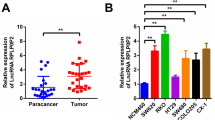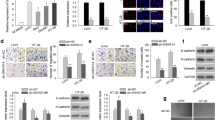Abstract
The roles of long non-coding RNAs (lncRNAs) have been discussed and analysed in previous studies. The messenger RNAs (mRNAs) are frequently reported to be regulated by lncRNAs in colorectal cancer (CRC). Here, we elucidated the role of the mRNA actin gamma 2 (ACTG2) in CRC progression using SW837 and LOVO cells. Gene expression was detected by real-time quantitative polymerase chain reaction (RT-qPCR) and subcellular localization was assessed using subcellular fractionation assay. Cell counting kit-8 (CCK-8), colony formation, and Transwell assays were performed to detect CRC cell phenotypes. RNA pulldown, luciferase reporter, and RNA immunoprecipitation (RIP) assays were conducted to reveal the interactions among microRNA-3918 (miR-3918), lncRNA mir-497-195 cluster host gene (MIR497HG) and ACTG2. The ACTG2 level was downregulated in CRC cells and samples. ACTG2 overexpression suppressed CRC cell proliferation, migration, and invasion. Additionally, miR-3918 inhibition increased the level of ACTG2 and the interaction between miR-3918 and ACTG2 was verified. MIR497HG was markedly downregulated in CRC cells and samples. Overexpression of MIR497HG decreased miR-3918 expression while increased ACTG2 expression. Further, the inhibitory effects exerted by MIR497HG overexpression on malignant phenotypes of CRC cells were reversed by ACTG2 knockdown. MIR497HG exerts inhibitory effects on CRC progression by the miR-3918/ACTG2 axis. Our study conducted a systematic analysis of the biological roles of ACTG2, miR-3918 and MIR497HG, and the relationship among them in CRC progression. ACTG2 and MIR497HG were found to be tumour suppressors in CRC cell growth. More importantly, a novel ceRNA network, with MIR497HG as a ceRNA to regulate the miR-3918/ACTG2 axis, was found to play a key role in CRC cell proliferation, migration and invasion.





Similar content being viewed by others
Change history
07 November 2022
A Correction to this paper has been published: https://doi.org/10.1007/s12041-022-01403-9
References
Chen D. L., Lu Y. X., Zhang J. X., Wei X. L., Wang F., Zeng Z. L. et al. 2017 Long non-coding RNA UICLM promotes colorectal cancer liver metastasis by acting as a ceRNA for microRNA-215 to regulate ZEB2 expression. Theranostics 7, 4836–4849.
Chorti A., Bangeas P., Papavramidis T. S. and Tsoulfas G. 2018 Role of MicroRNA in the diagnosis and therapy of hepatic metastases from colorectal cancer. Microrna 7, 167–177.
Das V., Kalita J. and Pal M. 2017 Predictive and prognostic biomarkers in colorectal cancer: a systematic review of recent advances and challenges. Biomed. Pharmacother. 87, 8–19.
Desterro J., Bak-Gordon P. and Carmo-Fonseca M. 2020 Targeting mRNA processing as an anticancer strategy. Nat. Rev. Drug Discov. 19, 112–129.
Edfeldt K., Hellman P., Westin G. and Stalberg P. 2016 A plausible role for actin gamma smooth muscle 2 (ACTG2) in small intestinal neuroendocrine tumorigenesis. BMC Endocr. Disord. 16, 19.
Eissa S., Safwat M., Matboli M., Zaghloul A., El-Sawalhi M. and Shaheen A. 2019 Measurement of urinary level of a specific competing endogenous RNA network (FOS and RCAN mRNA/ miR-324-5p, miR-4738-3p, /lncRNA miR-497-HG) enables diagnosis of bladder cancer. Urol Oncol. 3, e219-292.
Fadaka A. O., Pretorius A. and Klein A. 2019 Biomarkers for stratification in colorectal cancer: MicroRNAs. Cancer Control 26, 1073274819862784.
Fu T., Ji K., Jin L., Zhang J., Wu X., Ji X. et al. 2021 ASB16-AS1 up-regulated and phosphorylated TRIM37 to activate NF-κB pathway and promote proliferation, stemness, and cisplatin resistance of gastric cancer. Gastric Cancer 24, 45–59.
Guan Z., Song Y., Ma J., Li F., Zhao X., Liang G. et al. 2019 Altered expression of lncRNA NCK1-AS1 distinguished patients with prostate cancer from those with benign prostatic hyperplasia. Oncol. Lett. 18, 6379–6384.
Liang Z. X., Liu H. S., Wang F. W., Xiong L., Zhou C., Hu T. et al. 2019 LncRNA RPPH1 promotes colorectal cancer metastasis by interacting with TUBB3 and by promoting exosomes-mediated macrophage M2 polarization. Cell Death Dis. 10, 829.
Liu J., Li H., Zheng B., Sun L., Yuan Y. and Xing C. 2019 Competitive endogenous RNA (ceRNA) regulation network of lncRNA-miRNA-mRNA in colorectal carcinogenesis. Dig. Dis. Sci. 64, 1868–1877.
Lu T. X. and Rothenberg M. E. 2018 MicroRNA. J. Allergy Clin. Immunol. 141, 1202–1207.
Marković B. B. 2015 Prevention and early detection of colorectal cancer. Acta Med. Croatica 69, 365–371.
Ni W., Yao S., Zhou Y., Liu Y., Huang P., Zhou A. et al. 2019 Long noncoding RNA GAS5 inhibits progression of colorectal cancer by interacting with and triggering YAP phosphorylation and degradation and is negatively regulated by the m(6)A reader YTHDF3. Mol. Cancer. 18, 143.
Robichaud N., Sonenberg N., Ruggero D. and Schneider R.J. 2019 Translational Control in Cancer. Cold Spring Harb. Perspect. Biol. 11, a032896.
Rupaimoole R. and Slack F. J. 2017 MicroRNA therapeutics: towards a new era for the management of cancer and other diseases. Nat. Rev. Drug Discov. 16, 203–222.
Shan Y., Ma J., Pan Y., Hu J., Liu B. and Jia L. 2018 LncRNA SNHG7 sponges miR-216b to promote proliferation and liver metastasis of colorectal cancer through upregulating GALNT1. Cell Death Dis. 9, 722.
Shi L., Hong X., Ba L., He X., Xiong Y., Ding Q. et al. 2019 Long non-coding RNA ZNFX1-AS1 promotes the tumor progression and metastasis of colorectal cancer by acting as a competing endogenous RNA of miR-144 to regulate EZH2 expression. Cell Death Dis. 10, 150.
Song H., Zhong L. P., He J., Huang Y. and Zhao Y. X. 2019 Application of Newcastle disease virus in the treatment of colorectal cancer. World J. Clin. Cases 7, 2143–2154.
Szaryńska M., Olejniczak A. and Kmieć Z. 2016 The role of cancer stem cells in pathogenesis of colorectal cancer. Postepy Hig. Med. Dosw. (online) 70, 1469–1482.
Tang Q. and Hann S. S. 2018 HOTAIR: an oncogenic long non-coding RNA in human cancer. Cell Physiol. Biochem. 47, 893–913.
Wu Y., Liu Z. G., Shi M. Q., Yu H. Z., Jiang X. Y., Yang A. H. et al. 2017 Identification of ACTG2 functions as a promoter gene in hepatocellular carcinoma cells migration and tumor metastasis. Biochem. Biophys. Res. Commun. 491, 537–544.
Wu Y., Yang X., Chen Z., Tian L., Jiang G., Chen F. et al. 2019 m(6)A-induced lncRNA RP11 triggers the dissemination of colorectal cancer cells via upregulation of Zeb1. Mol. Cancer 18, 87.
Xuan W., Yu H., Zhang X. and Song D. 2019 Crosstalk between the lncRNA UCA1 and microRNAs in cancer. FEBS Lett. 593, 1901–1914.
Yang G., Wang X., Liu B., Lu Z., Xu Z., Xiu P. et al. 2019 circ-BIRC6, a circular RNA, promotes hepatocellular carcinoma progression by targeting the miR-3918/Bcl2 axis. Cell Cycle 18, 976–989.
Yang J., Yang F. J., Wang Y. G., Su G. F. and Miao X. 2020 LncRNA MIR497HG inhibits proliferation and migration of retinal endothelial cells under high-level glucose treatment via miRNA-128-3p/SIRT1 axis. Eur. Rev. Med. Pharmacol. Sci. 24, 5871–5877.
Yoshimi A., Lin K.T., Wiseman D.H., Rahman M.A., Pastore A., Wang B. et al. 2019 Coordinated alterations in RNA splicing and epigenetic regulation drive leukaemogenesis. Nature 574, 273–277.
Zhang X., Zhuang J., Liu L., He Z., Liu C., Ma X. et al. 2019 Integrative transcriptome data mining for identification of core lncRNAs in breast cancer. PeerJ. 7, e7821.
Zhou R. S., Zhang E. X., Sun Q. F., Ye Z. J., Liu J. W., Zhou D. H. et al. 2019a Integrated analysis of lncRNA-miRNA-mRNA ceRNA network in squamous cell carcinoma of tongue. BMC Cancer 19, 779.
Zhou Y., Xu Y., Lu L., Ni J., Nie J., Cao J. et al. 2019b Luminescent ruthenium(II) polypyridyl complexes acted as radiosensitizer for pancreatic cancer by enhancing radiation-induced DNA damage. Theranostics 9, 6665–6675.
Zhuang C., Liu Y., Fu S., Yuan C., Luo J., Huang X. et al. 2020 Silencing of lncRNA MIR497HG via CRISPR/Cas13d induces bladder cancer progression through promoting the crosstalk between Hippo/Yap and TGF-β/Smad signaling. Front. Mol. Biosci. 7, 616768.
Acknowledgement
This work was supported by South District of Guang’anmen Hospital, China Academy of Chinese Medical Sciences (Y2020-02).
Author information
Authors and Affiliations
Corresponding authors
Additional information
Corresponding editor: Murali Dharan Bashyam
Supplementary Information
Below is the link to the electronic supplementary material.
Rights and permissions
Springer Nature or its licensor (e.g. a society or other partner) holds exclusive rights to this article under a publishing agreement with the author(s) or other rightsholder(s); author self-archiving of the accepted manuscript version of this article is solely governed by the terms of such publishing agreement and applicable law.
About this article
Cite this article
Tang, G., Wu, D., Guo, M. et al. LncRNA MIR497HG inhibits colorectal cancer progression by the miR-3918/ACTG2 axis. J Genet 101, 27 (2022). https://doi.org/10.1007/s12041-022-01367-w
Received:
Revised:
Accepted:
Published:
DOI: https://doi.org/10.1007/s12041-022-01367-w




